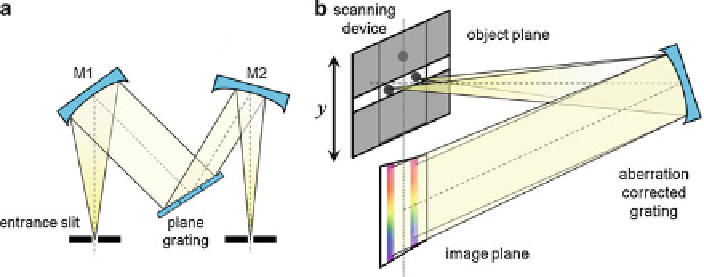Biomedical Engineering Reference
In-Depth Information
Fig. 4.13
Possible setting for spectrographs that can be used for spectral imaging.
a
Czerny-
Turner setup, one of the mirrors is toroidal.
b
A Rowland-based optical setup with an aberration-
corrected grating. This system does not require further optical elements for focusing the light to
the array detector
Czerny-Turner design (Fig.
4.13
a) or Ebert design that is not much different. In
order to correct those aberrations, a toroidal mirror is placed in the set of mirrors
in the spectrograph. A toroidal mirror has asymmetric vertical and horizontal radii
of curvatures which can compensate for the aforementioned spherical aberrations
when tuned correctly.
Another method for using a grating-based spectrograph with corrected perfor-
mance is to use aberration-corrected gratings. The grooves' spacing in these gratings
change in a systematic way that corrects the imaging performance of the device [
32
].
Sophisticated design capabilities together with optimized manufacturing techniques
enable to produce such gratings on either plane or concave surfaces. Using a design
that is based on Rowland mount with an aberration-corrected grating (Fig.
4.13
b), a
spectral imaging system with reasonable performance can be obtained.
4.4.3.2
Spectral Imaging System Based on a Prism
As described previously, prisms have higher transmission than gratings since
the whole transmitted light is diffracted to a single dispersion pattern, while a
grating device diffracts the light to higher dispersion orders. It therefore has the
potential to act as a good dispersion element, but in order to do that, the optical
aberrations should be reduced. An original design of a curved prism that corrects
the aberrations to a high level of accuracy using a concave mirror was developed by
Warren and Hackwell [
33
](Fig.
4.14
and is available commercially with a similar
instrumentation (Lightform Inc.)).
The last method for a spectrograph based on a prism that will be described
is based on the development of a prism-grating-prism (PGP) device [
34
,
35
], see
Fig.
4.15
. The advantage in this setup is that a very large spectral range can be
handled by the system; it is also robust and has a pipelike shape that enables an

Search WWH ::

Custom Search